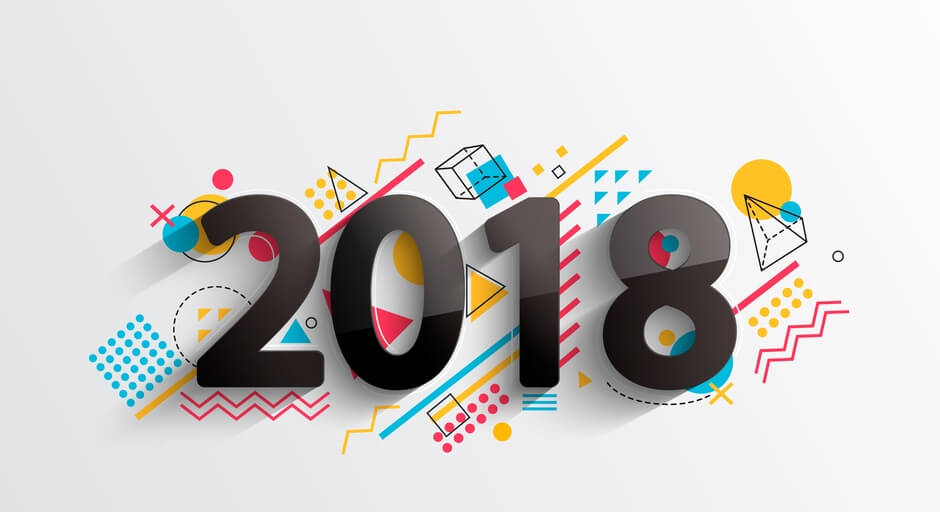The ways we interact with our devices are constantly changing. Be prepared in 2018.
User interests and expectations are constantly changing. They often reflect an evolving desire to increase delight, minimize friction, and meet growing needs. As voice interfaces, facial recognition, and augmented reality become mainstream, user experience and user interface design continues to be a crucial factor in digital product development, affecting all aspects of user satisfaction.
What is on the horizon for UX/UI in digital product design in 2018? Read on for our roundup of industry trends.
Simple, Card-based Websites
The use of mobile devices has drastically increased in recent years, and by now it’s crucial that every website be mobile-friendly. Simple card layouts are great for mobile web and apps, as they are an effective way to share a lot of information in a small space. They also allow for faster performance since multimedia content loads separately. Thanks to its inclusion in Google’s Material Design, the card-style trend is expected to stick around.
Another trend for web design is simpler navigation, and that means the death of the hamburger (three line) menu. At first widely adopted for its ability to save screen real estate, the hamburger quickly became despised for lowering discoverability and usability. Instead, many apps such as Facebook and Spotify have moved menu tabs to the bottom of the screen, making them more accessible while being easier to interact with and explore.
Augmented Reality
There are already a number of AR-based apps on the market today, particularly in games, toys, and entertainment (Pokémon Go, Lego AR-Studio, Snapchat filters, etc.). AR is being pushed further into the mainstream by showing up on the latest devices — iPhone X Animojis and Google Pixel AR Stickers. Last year, both Google and Apple released developer kits to make AR app development easier, and we should start seeing the results soon.
For the enterprise, AR use cases are emerging for product showcasing, such as apps from Amazon, Target, IKEA, and Wayfair, as well as 3D visualization for architecture, design, and real estate, among others.
Voice User Interface Design
Sales of voice-activated assistants such as Alexa, Siri, and OK Google soared this past year, with 1 in 5 users making a purchase via voice-controlled interface. By eliminating the need to type, the user experience is expedited and friction is reduced. With SDKs (Software Development Kits) available for developers, more companies have the opportunity to help customers use their products when they can’t (or don’t feel like) typing in the requests. This type of interface is particularly useful for the visually impaired, or for drivers, as their visual attention is occupied.
Designers will have to consider the myriad of ways in which menu navigation and commands are executed in non-screen interfaces, as well as the ability to complete goals and switch between interfaces. And while the traditional role of the UX/UI designer may not call for developing features such as tone of voice, speech cadence, and personality, they reflect the brand and are important to the user.
Omnichannel UX
As voice interfaces are designed, along with chatbots and Internet-connected devices, less emphasis is being placed on the website as a brand’s ‘storefront.’ Moving forward, websites are just one touchpoint among multiple channels, including voice and touch. Designers will need to consider how these various platforms can communicate consistently and support each other.
Personalization & Inclusiveness
Expect more personalized content and marketing in 2018. Our devices already track our location, preferences, and larger data profile, so with advancements in AI and machine learning, it’s only natural that more data will be utilized to make our experiences better and more customized.
Personalization is also about user-centric design, and layouts can be adapted to meet a user’s specific needs, such as larger fonts, louder audio, alternative text, and multiple ways to complete an action. Whether through widened user research or hiring a diverse design staff, or both, inclusion is now becoming an important part of the design process. More organizations are accepting of the mantra that the audience of a product is different from the designer behind it.
Biometric Authorization
From Touch ID to Face ID, biometric authorization methods are quickly replacing traditional password logins, not just to unlock phones, but to access banking apps, cloud storage, and more. Recognition by retina or voice are other integrations of this technology, and it’s expected that more apps will take advantage of these advanced security measures.
Conclusion
Although trends come and go, at the end of the day, success in UX/UI design comes down to aligning intuitive human interactions with specific business outcomes to deliver the most exceptional results for the user.
At Mission Data, our team of professional and creative UI/UX designers, developers, and strategists are passionate about helping clients see the bigger picture, whether they are redesigning an existing digital product or developing a project from scratch.
Have UX/UI project coming in 2018? Contact us today, we would love to hear from you.







